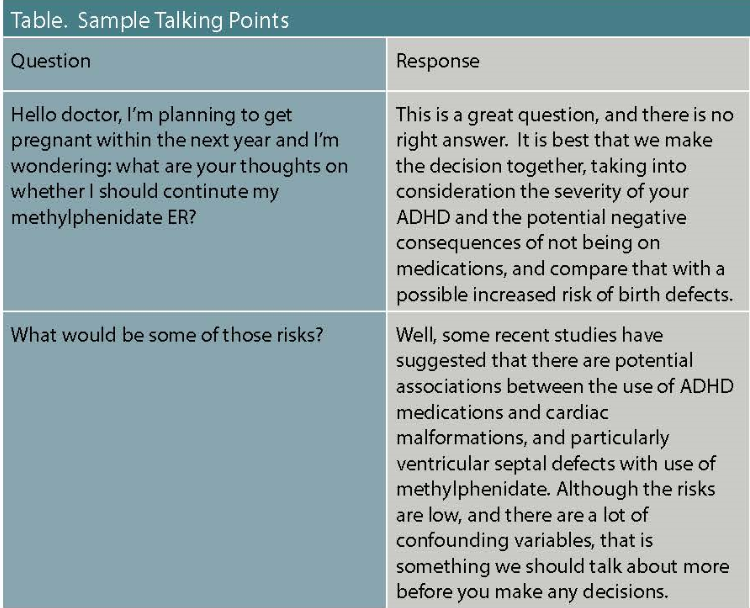Article
What to Expect When Your Patients With ADHD Are Expecting
Author(s):
A new study provides guidance for clinicians discussing the risks of ADHD medications with their pregnant patients.
Sondem/AdobeStock

Journal Club
Attention-deficit/hyperactivity disorder (ADHD) is a common condition and can be quite disabling, bearing important implications on individuals’ executive function. Among women of reproductive age, 3% suffer from ADHD and, especially in moderate to severe cases, the therapeutic benefits of stimulant medications are unmatched.1
Approximately 1 in 100 women were found to take ADHD medications during pregnancy, doubling the number from the late 1990s.2 Among them, a small increased risk of preeclampsia and preterm birth was found.3
As for teratogenicity, a study examining data from the National Birth Defects Prevention Study aimed to find associations between infants with birth defects and any maternal factors. When maternal ADHD treatment was considered, women who took ADHD medications during pregnancy (compared to those who did not) were found to have associated infants with birth defects including gastroschisis, omphalocele, and transverse limb deficiency. The study was criticized, however, for being based on a retrospective review of a small number of children with birth defects, and hence it added little value to literature related to ADHD safety in pregnancy (Table).
Sample Talking Points

Based on several population-based cohort studies, first trimester exposure to prescription stimulants was not found to be associated with increased risk of congenital anomalies.4,5 A 2018 meta-analysis of 8 cohort studies did not find an association between exposure to ADHD medication throughout pregnancy and any major malformation or cardiac malformations.6 But in another study from the United States and Nordic countries, which included 3474 methylphenidate-exposed pregnancies, researchers determined that methylphenidate was associated with an increased risk of cardiac malformations (RR = 1.27; 95% CI, 0.99-1.63).7
More research is needed to elucidate the safety of ADHD medications in pregnancy, including risks for birth defects. To date, all the data and studies on the pregnancy safety of these medications are restricted to live births, which may underestimate severe teratogenic effects that cause fetal demise or termination of pregnancy. The study discussed in this journal club addresses this limitation by including data from both prenatal and postnatal diagnoses of major malformations.
Structured Investigation
Question: What is the association between first trimester exposure to ADHD medications and major malformations?
Type of Study: Cross-sectional epidemiology study of singleton pregnancies in Denmark using data from several large Danish databases.
Population: The study population included data from 364,012 Danish singleton pregnancies with a live fetus at 12 gestational weeks (determined by ultrasound) and onwards between the dates of November 1, 2007 and February 1, 2014.8
Inclusion criteria for the exposed group in this study included any pregnancy in the first trimester after 11 gestational weeks, in which the mother was prescribed 1 or more ADHD medication (either methylphenidate, atomoxetine, modafinil, dextroamphetamine, lisdexamphetamine) from 28 days prior to conception through 70 days after conception (well into first trimester). Inclusion criteria for the unexposed group in this study were mothers who were not prescribed ADHD medications between 28 days prior to conception and 70 days after conception.8
Any pregnancy in which there were fetal chromosomal abnormalities were also excluded from the study.8
Method: Information about the patients included in the study was gleaned from the following Danish databases: Danish Fetal Medicine Database, Danish National Patient Registry, Danish Medical Birth Registry, and Danish Health Services Prescription Database.8
The study analyzed pregnancy outcomes for patients who were and were not exposed to ADHD medication during the first trimester. The primary endpoint for the study was defined as any major malformation overall (cardiac, central nervous system, eye, respiratory, orofacial clefts, face, digestive system, abdominal wall defect, urinary, genital, and limb). The secondary endpoints of the study were defined as either malformations of the heart or the central nervous system. Cardiac malformations were further classified into severe cardiac malformations (SCM) and non-SCM.8
Other pregnancy outcomes were also considered, again comparing ADHD-exposed with unexposed groups: pregnancy terminations at 11 weeks or later, miscarriages at less than 22 weeks, stillborn/singleton at later than 22 weeks, or live born.8
The study also carried out a sensitivity analysis, where first-trimester exposure was redefined as someone who has been prescribed 2 or greater ADHD medications.8
Statistical Analysis
The authors of the study used log-binomial regression in order to determine prevalence ratios (PR) with a 95% CI between exposed and unexposed groups. Prevalence ratios were presented as either crude, minimally adjusted, or fully adjusted. Minimally adjusted prevalence ratios included the following covariates: age and smoking status. Fully adjusted prevalence ratios included the following covariates: ethnicity, civil status, parity, age, BMI, smoking status, exposure to teratogens, exposure to antihypertensives, exposure to antidiabetics, use of other psychotropic drugs, and a diabetes diagnosis.8
Results
The following results are some of the pertinent positive and negative findings from the study. Not all of the results from the study are included below, but instead the ones that are relevant to our discussion.8
For the primary endpoint, the crude PR comparing any ADHD medication vs. unexposed was 1.10 with a 95% CI between 0.77 and1.57, and the adjusted PR was 0.98, with a CI between 0.68 and 1.41. For methylphenidate vs unexposed, the crude PR was 1.09 with a CI between 0.74 and 1.61, and the adjusted PR was 1.04 with CI between 0.70 and 1.55. For modafinil vs unexposed, the crude PR was 2.87 with a CI between 1.15 and 7.15, and the fully adjusted PR was not calculated since there were too few cases to perform this type of analysis (the crude PR is also likely falsely elevated due to a small sample size with a small number of skewed results). For atomoxetine vs unexposed, the crude PR was 1.22 with a CI of 0.52 to 2.87, and the fully adjusted PR was 1.15 with a CI of 0.49-2.69.8
For any cardiac malformations, crude PR for any ADHD medication vs unexposed was 2.05 (95% CI 1.17-3.59), and the fully adjusted PR was 1.75 (95% CI 1.00-3.06). For methylphenidate specifically vs unexposed, the crude PR was 2.06 (95% CI 1.11-3.80), and the fully adjusted PR was 1.65 (95% CI 0.89-3.05).8
For SCM, crude PR for any ADHD medication vs unexposed was 3.63 (95% CI 1.51-8.71), and the fully adjusted PR was 3.23 (95% CI 1.35-7.74). The crude PR for methylphenidate vs unexposed was 3.49 (95% CI 1.31-9.29), and the fully adjusted PR was 2.59 (95% CI 0.98-6.90). Of note, the sample sizes for both the any ADHD medication group (5/569) and the methylphenidate group (< 5/473) were small, potentially skewing the PR as a result.8
For ventricular septal defect (VSD), crude PR for any ADHD medication vs unexposed was 2.12 (95% CI 0.80-5.65), and the fully adjusted PR was 2.57 (95% CI 0.96-6.83). The crude PR for methylphenidate vs unexposed was 2.56 (95% CI 0.96-6.79), and the fully adjusted PR was 2.74 (95% CI 1.03-7.28). Of note again, the sample size of the methylphenidate group was small (< 5/473), potentially skewing the PR as a result.8
For CNS malformations, crude PR for any ADHD medications vs unexposed was 2.03 (95% CI 0.76-5.39), and the fully adjusted PR was 1.66 (95% CI 0.54-5.13). Crude PR for methylphenidate vs unexposed was 2.44 (95% CI 0.92-6.48), and the fully adjusted PR was 2.03 (95% CI 0.65-6.27).8
Discussion
During the period between 2007 and 2014, the authors of the study also found that there was a 5-fold increase in ADHD medication use among the pregnant population in Denmark, highlighting the importance of understanding the effects of these medications in pregnancy.
Unlike previous studies exploring the association between ADHD medications and impact on pregnancy, this highly powered cross-sectional study is the first not to limit outcomes strictly to live births. Instead, the study also attempted to include data on severe malformations that led to spontaneous or induced pregnancy loss.
When zooming into statistically significant findings, exposure to any ADHD medication (methylphenidate, atomoxetine, modafinil, dextroamphetamine, lisdexamphetamine) had a higher likelihood of being correlated with cardiac malformations in comparison to the unexposed group with a fully adjusted PR of 1.75. Exposure to any of the included ADHD medication was also more likely to be correlated to SCM with a fully adjusted PR of 3.23, though this number should be considered in the context of a small sample size (5/569), and the PR could be skewed above its true value. In the study, SCM included terminations, miscarriage, death, or surgery. The study also found an association between methylphenidate usage and ventral septal defects in comparison to the unexposed group with a fully adjusted PR of 2.74. Again, this number should be evaluated in the context of a small sample size(< 5/473), and the PR could be potentially skewed.
Similar to other studies, the authors did not find any association between ADHD medications and major malformations in general. There was no clinically significant association seen between methylphenidate and malformations overall. However, this study found that there is in fact a clinically significant association between overall ADHD medication use and cardiac malformations and SCM, as well methylphenidate use and VSDs, which can help inform counseling around ADHD medication usage during pregnancy. In fact, the absolute risk and prevalence of cardiac malformations among the exposed group for any ADHD medication was 2% (12/569), which is double that of the general population (1%).9,10
Study Limitations
1. Study population is limited to Danish women of reproductive age, hence may not be generalizable to other potentially more diverse populations.
2. The majority of exposed pregnancies (473/569, 83%) in the study were exposed to methylphenidate. As a result, conclusions related to the “any ADHD” medication group are heavily skewed towards factors related to methylphenidate usage, making it harder to glean clinical recommendations around ADHD medications more popular in North America, such as lisdexamphetamine and dextroamphetamine/amphetamine.
3. The authors do not know if all study participants actually took ADHD medications (only know it was prescribed), and the dosage of ADHD medications taken were not taken into account.
4. There was no way to account for misuse of prescribed medication and how it factors into the overall outcome.
5. The study did not take into consideration participants’ comorbid SUD history (ie, are they also using other teratogenic substances).
Clinical Bottom Line
With the prevalence of ADHD treatment longitudinally, a greater number of women will end up on ADHD medications or wanting to continue on them during pregnancy. It is important to further elucidate the risks that these medications may impose on the fetus. From this study and previous ones, there is a signal that cardiac malformations may be associated with in utero exposure, and particularly VSD with methylphenidate products. However, the absolute risks of any major malformation are low at 2%.
When encountering patients who want to become pregnant or who are pregnant, a risk/benefit discussion about the use of ADHD medications during pregnancy should occur. This discussion should include the potential risks to the mother of untreated ADHD during pregnancy, especially during the first trimester, as compared to the potential risks of malformations, especially cardiac malformation, to the developing fetus.
Mr Praharaj is a 5th year MD, MBA candidate at Dartmouth’s Geisel school of Medicine and Tuck School of Business. Dr Stanciu is assistant professor of psychiatry at Dartmouth’s Geisel School of Medicine and Director of Addiction Services at New Hampshire Hospital, Concord, NH. He is Addiction Section Editor for Psychiatric TimesTM. The author reports no conflicts of interest concerning the subject matter of this article.
References:
1. Baker AS, Freeman MP. Management of attention deficit hyperactivity disorder during pregnancy. Obstet Gynecol Clin North Am. 2018;45(3):495-509.
2. Anderson KN, Dutton AC, Broussard CS,. ADHD Medication use during pregnancy and risk for selected birth defects: National Birth Defects Prevention Study, 1998-2011. J Atten Disord. 2020;24(3):479-489.
3. Cohen JM, Hernández-Díaz S, Bateman BT, et al. Placental complications associated with psychostimulant use in pregnancy. Obstet Gynecol. 2017;130(6):1192-1201.
4. Källén B, Borg N, Reis M. The use of central nervous system active drugs during pregnancy. Pharmaceuticals (Basel). 2013;6(10):1221-86.
5. Pottegård A, Hallas J, Andersen JT, et al. First-trimester exposure to methylphenidate: a population-based cohort study. J Clin Psychiatry. 2014;75(1):e88-93.
6. Jiang HY, Zhang X, Jiang CM, Fu HB. Maternal and neonatal outcomes after exposure to ADHD medication during pregnancy: A systematic review and meta-analysis. Pharmacoepidemiol Drug Saf. 2019;28(3):288-295.
7. Huybrechts KF, Bröms G, Christensen LB, et al. Association between methylphenidate and amphetamine use in pregnancy and risk of congenital malformations: a cohort study from the International Pregnancy Safety Study Consortium. JAMA Psychiatry. 2018;75(2):167-175.
8. Kolding L, Ehrenstein V, Pedersen L, et al. Associations between ADHD medication use in pregnancy and severe malformations based on prenatal and postnatal diagnoses: a Danish registry-based study. J Clin Psychiatry. 2021;82(1):20m13458.
9. Hoffman JI, Kaplan S. The incidence of congenital heart disease. J Am Coll Cardiol. 2002;39(12):1890-900.
10. Reller MD, Strickland MJ, Riehle-Colarusso T, et al. Prevalence of congenital heart defects in metropolitan Atlanta, 1998-2005. J Pediatr. 2008;153(6):807-13.





